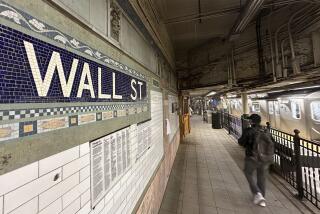GDP Data Lend Credence to Expectation of Steady Rates
WASHINGTON — The economy grew at a faster clip and inflation was slower than originally reported in the second quarter, a government report said Wednesday, suggesting the Federal Reserve would keep interest rates steady.
The economy grew at a 2.9% annual pace in the second quarter, faster than the 2.5% rate initially reported but marginally below what analysts were expecting, as higher business investment offset a drop in residential construction, a Commerce Department report showed.
At the same time, an inflation gauge favored by the Federal Reserve -- which measures personal consumption expenditure prices minus food and energy -- was revised to 2.8%, the biggest rise since the first quarter of 2001. The inflation index originally was reported to have risen by 2.9% when figures were released last month.
“Overall we are seeing softer inflationary pressures,” said Kathy Lien, chief strategist at Forex Capital Markets in New York. The report lessens “the likelihood that the Fed will have to resume rate hikes any time soon,” she said.
But Richmond Fed President Jeffrey Lacker said Wednesday that slowing growth may not be enough to offset inflation.
“I think there is a danger of inflation becoming entrenched at the level it is now,” Lacker, the lone dissenter in the Fed’s Aug. 8 decision to keep rates steady, told Bloomberg TV.
Analysts polled by Reuters were expecting gross domestic product growth estimates for the April-June quarter to be revised up to a 3% annual pace.
A separate report by the ADP Employer Services showed private-sector employers added 107,000 jobs in August.
The data come two days before the government’s nonfarm payrolls report, which is expected to show 120,000 new jobs in the month.
Setting aside the Hurricane Katrina-affected final quarter of last year, the economy in the second quarter grew at the slowest pace since a 2.6% gain in the fourth quarter of 2004, as homebuilding investment suffered its biggest decline in more than 10 years, the Commerce Department said.
Business spending on buildings, plants and factories rose by 22.2% in the second quarter, more than originally thought. It was the biggest gain in nonresidential fixed investment in structures since the second quarter of 1994.
However, in a sign the housing sector is cooling rapidly, investment on residential structures fell 9.8%, the biggest decline since a 12.2% fall in the second quarter of 1995, the Commerce Department said.
Also, mortgage applications fell for the first time in four weeks as demand for home purchase loans dropped to the lowest level in nearly three years, a report from the Mortgage Bankers Assn. said.
More to Read
Inside the business of entertainment
The Wide Shot brings you news, analysis and insights on everything from streaming wars to production — and what it all means for the future.
You may occasionally receive promotional content from the Los Angeles Times.










